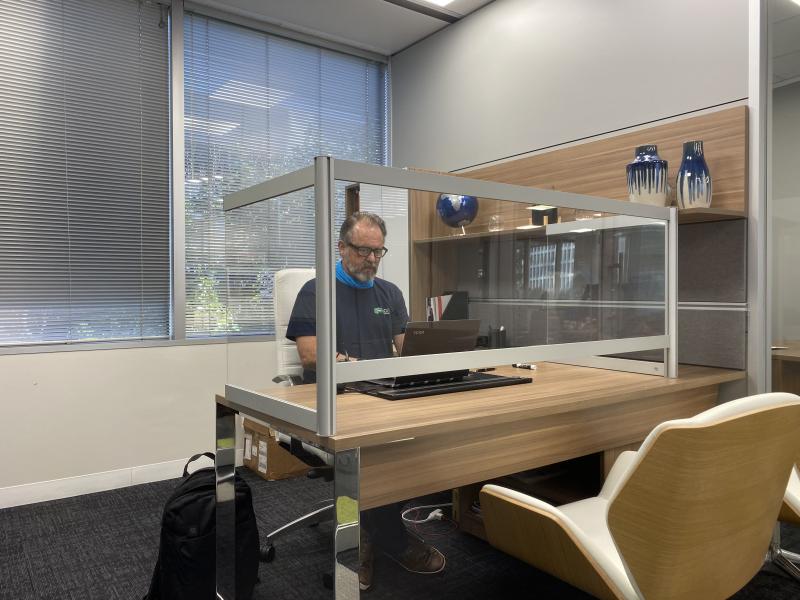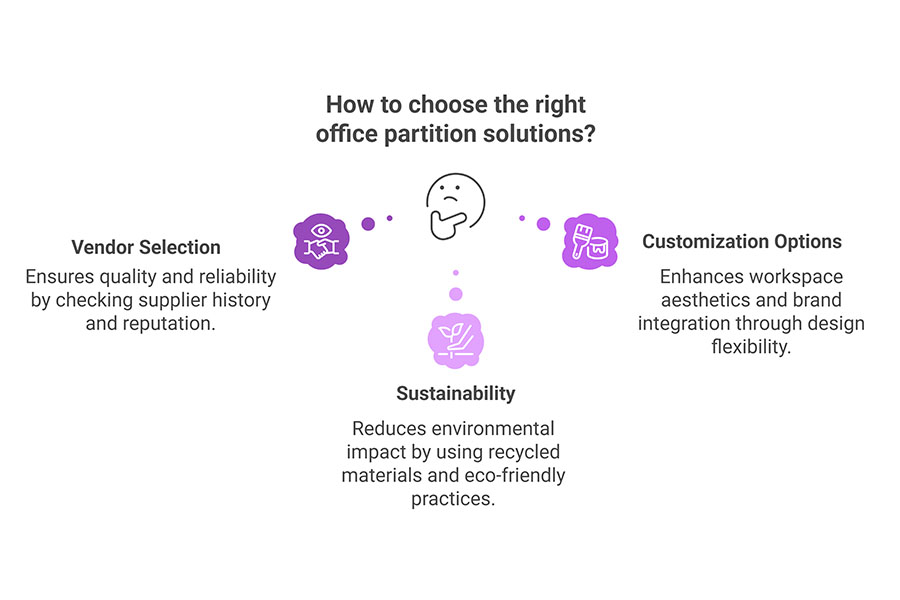Office Partitions – Setting Up To Return To The Office

Following the global pandemic, we can no longer view workplaces with the same perspective as before.
The post-Corona world has forced us to redefine the business environment.
Now more than ever, employee health, flexibility, and comfort have become the main focus of office space design.
In a space where the boundary between work and comfort must be clearly defined, the role of creative elements, such as office partitions, in creating a safe, dynamic, and efficient environment has become more prominent than ever.
In this article, we will take a look at the evolution of workspaces and the role of office partitions after the coronavirus pandemic.
The Role of Office Partitions in Modern Office Design
In today’s businesses, where health and productivity are two inseparable principles, partitions serve as a fundamental principle in the interior design of modern office space.
Employee health and safety were initially one of the most important reasons why offices turned to using office partitions.
By creating physical distance between employees, these dividers not only prevent the spread of diseases but also increase the sense of psychological safety in the workplace.
But today, along with safety, privacy, and focus, are also among the most important reasons for using partitions.
In open, busy spaces, office partitions, as lightweight, modular walls, provide employees with the silence needed to focus and think.
This office equipment is very useful for increasing productivity in individual work or duties that require high concentration.
On the other hand, one of the benefits of office partitions is space optimization.
With the correct use of partitions, even the smallest offices can create spaces for meetings, group collaboration, or individual activities, without the need for permanent construction or heavy costs.
Types of Office Partitions
With the growing need for versatile and flexible workspaces, understanding the types of office partitions can help create an efficient, beautiful, and adaptable environment for changing needs.
Below, we will learn about the most common types of partitions and their features.
Office partitions make it possible to retrofit your current office furniture Houston with barriers.
Plus, the wide variety of styles and materials can be adapted to suit most layouts.
Modern office partitions are sleek and minimal in design.
Below, we will learn about the most common types of partitions and their features.
Fixed Partitions
These types of office partitions are a permanent solution for separating different workspaces and are commonly used to create conference rooms, private offices, or different teams within a business.
They have a solid, unchanging structure and are used for long-term, stable office use.
Modular Partitions
If your business needs a flexible and dynamic space, modular office partitions are a great option for these spaces.
These partitions are easy to install, move, and rearrange, allowing companies to quickly adapt their space to changing needs and teams.
Mobile Partitions
For spaces that are dynamic and changing, mobile or wheeled partitions are the best choice.
These office partitions are easily moved, allowing the workspace to change in an instant according to the company’s needs.
From creating a short meeting space to separating workstations for group work, movable and mobile partitions can be used.
Counter Shields
Loftwall Counter Shield Acrylic Screens provide a quick solution for reception desks, check out counters, and more.
These aluminum frame screens can be linked together for larger areas. Easy to assemble and clean, the Counter Shield comes in four different models.
These shields create a transparent barrier, enabling safe interaction between staff and customers.
Their simple and modern design also does not detract from the beauty of the environment and harmonizes with most decor.

Desk Dividers
Hitch Floor and Desktop Panels are freestanding, designed to be used with your existing furniture. In addition, they have a height-adjustable foot for use with tall/standing desks.
Gain privacy without sacrificing natural light, or opt for a dry erase panel to add valuable writing space.
Another option for freestanding barriers is the Split Acrylic Floor Panel.
These portable panels are easy to set up anywhere and are available in clear or frosted finishes.
The minimalist design of these dividers adds beauty to your workspace while maintaining functionality.
Their easy portability also provides great flexibility for changing layouts.
Material Considerations
The choice of office partition material has a great impact on its appearance, durability, and acoustic performance.
For example, glass partitions with a modern and transparent appearance allow light to pass through easily and create a bright space.
Wooden partitions are classic and sturdy and are suitable for formal and management spaces.
Some office partition models have a fabric covering that absorbs ambient noise and creates a peaceful and quiet environment for employees.

Designing with Office Partitions for the Hybrid Workforce
With the increasing popularity of hybrid work models in today’s businesses, where some employees work in person and some work remotely, office design requires innovation and creativity.
One of these innovations is office partitions, which have become important equipment for creating flexible and efficient spaces.
Below, we will examine in detail three important principles of partitioned design for the hybrid work model.
- Flexible Layouts: Modern and dynamic workspaces should be able to easily adapt to different conditions.
Partitions allow designers to design office spaces in a modular and mobile way.
It is designed in such a way that balance can be established between in-person employees, group meetings, and communication with remote colleagues.
This flexibility in the workplace can increase people’s efficiency and job satisfaction.
- Technology Integration: In a hybrid workspace, one of the important principles of communication between employees is technology.
The design of partitions should allow for easy installation and use of technological tools such as screens, webcams, conference microphones, and sound systems.
Some office partition models have the ability to install equipment and pass through cables, which can provide efficient spaces for holding video conferencing meetings.
- Employee Well-being: office partitions should be able to help increase the quality of employees’ work life and maintain their health.
Using appropriate materials, paying attention to the passage of natural light, proper ventilation, and maintaining visual connection with the space all play an important role in maintaining the mental and physical health of employees.
For example, by using transparent or translucent office partitions next to windows, natural light can be diffused throughout the workspace.
The design of acoustic partitions also helps reduce noise and increase employee concentration.
Best Practices for Implementation
In order for partitions to have the greatest impact on improving workspaces, in addition to considering their material and type, attention must also be paid to how they are implemented.
A professional and targeted implementation process plays an essential role in the success of this solution.
Below, we will discuss the most important principles and steps in implementing partitions in office environments.
- Space Assessment: The first step in implementing office partitions is a comprehensive review of the current office layout.
This includes measuring spaces, circulation routes, where tables and chairs will be placed, and how the space will be used at different times.
With an assessment, you can determine which spaces need to be separated and how you can increase the efficiency of the space with minimal changes.
- Employee Input: The purpose of implementing partitions is to improve the workspace for employees, so their feedback and needs are important.
Some employees may need a quiet and peaceful space to work, while others may need interaction and teamwork.
Conducting a survey can provide valuable information to the design team.
- Professional Consultation: Working with interior designers, architects, or office space consultants can make a big difference in the implementation of office partitions.
Based on their experience and knowledge, these experts can provide solutions that are both visually appealing and aligned with business needs.
- Budgeting and ROI: Before implementing partitions in your office, you should consider the cost and efficiency.
Be careful that when choosing partitions, you must balance their price, quality, durability, and long-term value.
Sometimes spending more on partitions with high durability, better acoustic properties, or portability will save you more money in the long run and increase employee productivity.
As a result, choosing this equipment should not be viewed solely in terms of cost, but rather as an investment in team performance and satisfaction.
Choosing the Right Partition Solutions

If you plan to use office partitions to create a productive workspace, you should choose a product that not only meets your needs but is also compatible with your business values and sustainability principles.
Below, we will examine three essential principles for choosing the right partition.
- Vendor Selection: Before purchasing, check the history, reputation, and portfolio of partition suppliers or manufacturers.
You should consider criteria such as build quality, product warranty, and after-sales service.
Collaborating with companies that have experience working with similar organizations reduces implementation risks.
- Customization Options: Partitions are a visible part of the workspace and have a huge impact on the appearance of the space, decoration, and brand.
Choosing office partitions with custom design capabilities, such as color, texture, logo, and shape, can help to integrate the interior design.
Some brands even use partitions as a decorative element.
- Sustainability: Despite environmental issues, organizations are looking for environmentally friendly solutions.
Using partitions that are made with recycled materials and are recyclable can be effective in reducing environmental impacts and demonstrate a business’s commitment to sustainability.
Also, suppliers who follow environmental standards in their production are more reliable choices.
Conclusion
Considering the changes in work practices and models, futuristic workspace design has become increasingly important.
Meanwhile, partitions are no longer considered as physical walls, but rather as equipment to improve workspace and create a flexible environment.
The conscious and purposeful use of office partitions in office design can be an effective response to the needs of the hybrid work model, hygiene requirements, and individual employee desires.
Needs such as creating privacy, reducing noise pollution, improving aesthetics, and providing a suitable infrastructure for new technologies.
Choosing and implementing partitions correctly is an effective step towards creating spaces that simultaneously increase productivity, creativity, and job satisfaction.
At Collaborative Office Interiors, let us help you get your office ready to go, complete with partitions where necessary.
We have the design know-how and resources to ease your mind and make your employees feel comfortable.
As a result, you will feel more confident returning to the office with your team.
Contact us for a free consultation to discuss your needs.

John Ofield is the owner of Collaborative Office Interiors. Houston’s trusted source for modern and commercial office furniture, office cubicles, demountable walls, office desks and tables, and complete workspace solutions. With more than 40 years of experience, he combines deep product knowledge with hands-on space-planning expertise to create ergonomic, productivity-focused work environments for businesses across Southeast Texas.


